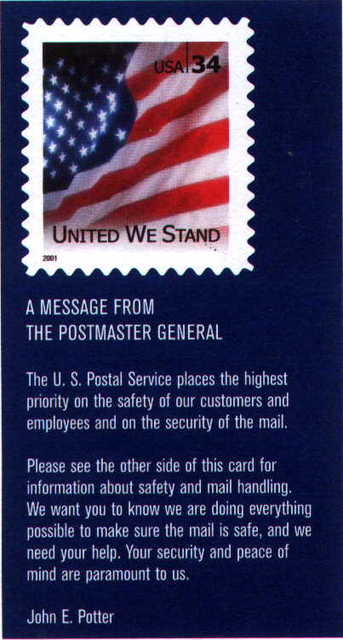Neighborhood Planning Unit X
9-11 Are You Still Cautious Years Later?

United States Post Office & CDC Suggestions
Taken from an official United States Post Office mailing:
What should make me suspect a piece of mail?
- It's unexpected or from someone you dont know.
- It's addressed to someone no longer at your address.
- It's handwritten and has not return address or bears one that you can't confirm is legitimate.
- It's lopsided or lumpy in appearance.
- It's sealed with excessive amounts of tape.
- It's marked with restrictive endorsements such as "Personal" or "Confidential."
- It has excessive postage.
What should I do with a suspicious
peice of mail?
- Don't handle a letter or package that you suspect is contaminated.
- Don't shake it, bump it, or sniff it.
- Wash you hands thoroughly with soap and water.
Notify local law enforcement authorities.
This is an official CDC Health Advisory
Distributed via Health Alert Network October 12, 2001, 21:00 EDT (9:00 PM EDT)
HOW TO HANDLE ANTHRAX AND OTHER BIOLOGICAL AGENT THREATS
Many facilities in communities around the country have received anthrax threat letters. Most were empty envelopes; some have contained powdery substances. The purpose of these guidelines is to recommend procedures for handling such incidents.
DO NOT PANIC
- Anthrax organisms can cause infection in the skin, gastrointestinal system, or the lungs. To do, so the organism must be rubbed into abraded skin, swallowed, or inhaled as a fine, aerosolized mist. Disease can be prevented after exposure to the anthrax spores by early treatment with the appropriate antibiotics. Anthrax is not spread from one person to another person.
- For anthrax to be effective as a covert agent, it must be aerosolized into very small particles. This is difficult to do, and requires a great deal of technical skill and special equipment. If these small particles are inhaled, life-threatening lung infection can occur, but prompt recognition and treatment are effective.
- Do not shake, open or empty the contents of any suspicious envelope or package.
- PLACE the envelope or package in a plastic bag or some other type of container to prevent leakage of contents.
- If you do not have any container, then COVER the envelope or package with anything (e.g., clothing, paper, trash can, etc.) and do not remove this cover.
- Then LEAVE the room and CLOSE the door, or section off the area to prevent others from entering (i.e., keep others away).
- WASH your hands with soap and water to prevent spreading any powder to your face.
- What to do next?…
Suspicious unopened letter or package marked with
a threatening message such as "ANTHRAX".
- If you are at work, then report the incident to your building security official or an available supervisor who should notify police and other authorities.
- If you are at home, then report the incident to local police.
- LIST all people who were in the room or area when this suspicious letter or package was recognized. Give this list to both the local public health authorities and law enforcement officials for follow-up investigations and advice.
Data from the US Postal Service shows that over 200 billion pieces of mail are delivered each year. During the last year, of these billions of pieces of mail, they only received approximately 60 threats or hoaxes which included anthrax, hoof and mouth disease, the Klingerman virus hoax and others.
Local, state, and Federal health and emergency program officials are prepared to deal with terrorist activities involving release of anthrax spores. The Postal Service is coordinating with these officials to ensure quick and effective response to any such activities. The remote, but real, possibility that anthrax will be introduced into the mail stream requires that the above outlined procedures be strictly followed.
What constitutes a "suspicious parcel"?
Some typical characteristics Postal Inspectors have detected over the years, which ought to trigger suspicion, include parcels that:
- are unexpected or from someone unfamiliar to you.
- are addressed to someone no longer with your organization or are otherwise outdated.
- have no return address, or have one that can't be verified as legitimate.
- are of unusual weight, given their size, or are lopsided or oddly shaped.
- are marked with restrictive endorsements, such as "Personal" or "Confidential."
- have protruding wires, strange odors or stains.
- show a city or state in the postmark that doesn't match the return address.


